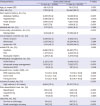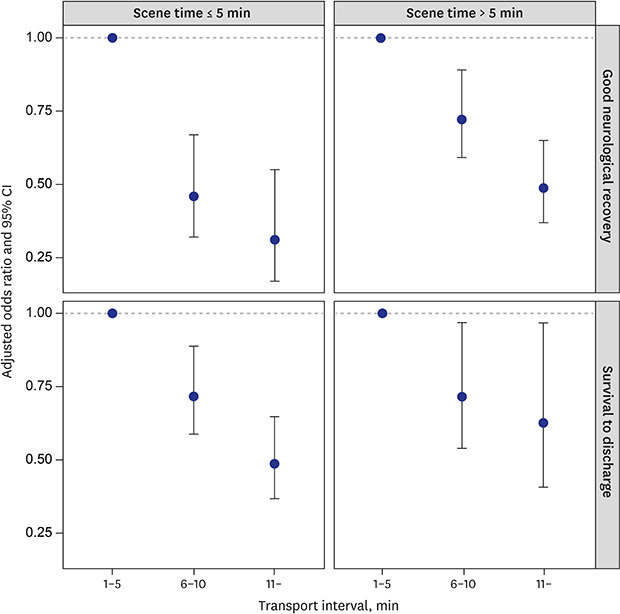1. Berdowski J, Berg RA, Tijssen JG, Koster RW. Global incidences of out-of-hospital cardiac arrest and survival rates: systematic review of 67 prospective studies. Resuscitation. 2010; 81(11):1479–1487.


2. Yang HJ, Kim GW, Kim H, Cho JS, Rho TH, Yoon HD, et al. Epidemiology and outcomes in out-of-hospital cardiac arrest: a report from the NEDIS-based cardiac arrest registry in Korea. J Korean Med Sci. 2015; 30(1):95–103.


4. Lyon RM, Clarke S, Gowens P, Egan G, Clegg GR. Resuscitation quality assurance for out-of-hospital cardiac arrest--setting-up an ambulance defibrillator telemetry network. Resuscitation. 2010; 81(12):1726–1728.

5. Kronick SL, Kurz MC, Lin S, Edelson DP, Berg RA, Billi JE, et al. Part 4: systems of care and continuous quality improvement: 2015 American Heart Association Guidelines update for cardiopulmonary resuscitation and emergency cardiovascular care. Circulation. 2015; 132(18):Suppl 2. S397–S413.
6. Davis DP, Fisher R, Aguilar S, Metz M, Ochs G, McCallum-Brown L, et al. The feasibility of a regional cardiac arrest receiving system. Resuscitation. 2007; 74(1):44–51.


7. Herlitz J, Ekström L, Axelsson A, Bång A, Wennerblom B, Waagstein L, et al. Continuation of CPR on admission to emergency department after out-of-hospital cardiac arrest. Occurrence, characteristics and outcome. Resuscitation. 1997; 33(3):223–231.


8. Cha WC, Lee SC, Shin SD, Song KJ, Sung AJ, Hwang SS. Regionalisation of out-of-hospital cardiac arrest care for patients without prehospital return of spontaneous circulation. Resuscitation. 2012; 83(11):1338–1342.


9. Spaite DW, Bobrow BJ, Vadeboncoeur TF, Chikani V, Clark L, Mullins T, et al. The impact of prehospital transport interval on survival in out-of-hospital cardiac arrest: implications for regionalization of post-resuscitation care. Resuscitation. 2008; 79(1):61–66.


10. Spaite DW, Stiell IG, Bobrow BJ, de Boer M, Maloney J, Denninghoff K, et al. Effect of transport interval on out-of-hospital cardiac arrest survival in the OPALS study: implications for triaging patients to specialized cardiac arrest centers. Ann Emerg Med. 2009; 54(2):248–255.

11. Geri G, Gilgan J, Wu W, Vijendira S, Ziegler C, Drennan IR, et al. Does transport time of out-of-hospital cardiac arrest patients matter? A systematic review and meta-analysis. Resuscitation. 2017; 115:96–101.


12. Havel C, Schreiber W, Riedmuller E, Haugk M, Richling N, Trimmel H, et al. Quality of closed chest compression in ambulance vehicles, flying helicopters and at the scene. Resuscitation. 2007; 73(2):264–270.


13. Kurz MC, Dante SA, Puckett BJ. Estimating the impact of off-balancing forces upon cardiopulmonary resuscitation during ambulance transport. Resuscitation. 2012; 83(9):1085–1089.

14. Skogvoll E, Eftestøl T, Gundersen K, Kvaløy JT, Kramer-Johansen J, Olasveengen TM, et al. Dynamics and state transitions during resuscitation in out-of-hospital cardiac arrest. Resuscitation. 2008; 78(1):30–37.


15. Sanders AB, Kern KB, Berg RA, Hilwig RW, Heidenrich J, Ewy GA. Survival and neurologic outcome after cardiopulmonary resuscitation with four different chest compression-ventilation ratios. Ann Emerg Med. 2002; 40(6):553–562.


16. Yang CL, Wen J, Li YP, Shi YK. Cardiocerebral resuscitation vs cardiopulmonary resuscitation for cardiac arrest: a systematic review. Am J Emerg Med. 2012; 30(5):784–793.


17. Shin SD, Kitamura T, Hwang SS, Kajino K, Song KJ, Ro YS, et al. Association between resuscitation time interval at the scene and neurological outcome after out-of-hospital cardiac arrest in two Asian cities. Resuscitation. 2014; 85(2):203–210.


18. Kim TH, Shin SD, Kim YJ, Kim CH, Kim JE. The scene time interval and basic life support termination of resuscitation rule in adult out-of-hospital cardiac arrest. J Korean Med Sci. 2015; 30(1):104–109.


19. Lee YJ, Hwang SS, Shin SD, Lee SC, Song KJ. Effect of national implementation of telephone CPR program to improve outcomes from out-of-hospital cardiac arrest: an interrupted time-series analysis. J Korean Med Sci. 2018; 33(51):e328.

20. Ro YS, Shin SD, Lee YJ, Lee SC, Song KJ, Ryoo HW, et al. Effect of dispatcher-assisted cardiopulmonary resuscitation program and location of out-of-hospital cardiac arrest on survival and neurologic outcome. Ann Emerg Med. 2017; 69(1):52–61.e1.


21. Ro YS, Shin SD, Song KJ, Lee EJ, Kim JY, Ahn KO, et al. A trend in epidemiology and outcomes of out-of-hospital cardiac arrest by urbanization level: a nationwide observational study from 2006 to 2010 in South Korea. Resuscitation. 2013; 84(5):547–557.


22. Edgren E, Hedstrand U, Kelsey S, Sutton-Tyrrell K, Safar P. BRCT I Study Group. Assessment of neurological prognosis in comatose survivors of cardiac arrest. Lancet. 1994; 343(8905):1055–1059.


24. Hasegawa K, Hiraide A, Chang Y, Brown DF. Association of prehospital advanced airway management with neurologic outcome and survival in patients with out-of-hospital cardiac arrest. JAMA. 2013; 309(3):257–266.


25. Shin SD, Ahn KO, Song KJ, Park CB, Lee EJ. Out-of-hospital airway management and cardiac arrest outcomes: a propensity score matched analysis. Resuscitation. 2012; 83(3):313–319.

26. Ro YS, Shin SD, Song KJ, Park CB, Lee EJ, Ahn KO, et al. A comparison of outcomes of out-of-hospital cardiac arrest with non-cardiac etiology between emergency departments with low- and high-resuscitation case volume. Resuscitation. 2012; 83(7):855–861.


27. Calle PA, De Paepe P, Van Sassenbroeck D, Monsieurs KG. External artifacts by advanced life support providers misleading automated external defibrillators. Resuscitation. 2008; 79(3):482–489.


28. Bobrow BJ, Clark LL, Ewy GA, Chikani V, Sanders AB, Berg RA, et al. Minimally interrupted cardiac resuscitation by emergency medical services for out-of-hospital cardiac arrest. JAMA. 2008; 299(10):1158–1165.


29. Bernard SA, Gray TW, Buist MD, Jones BM, Silvester W, Gutteridge G, et al. Treatment of comatose survivors of out-of-hospital cardiac arrest with induced hypothermia. N Engl J Med. 2002; 346(8):557–563.


30. Hypothermia after Cardiac Arrest Study Group. Mild therapeutic hypothermia to improve the neurologic outcome after cardiac arrest. N Engl J Med. 2002; 346(8):549–556.

31. Langhelle A, Tyvold SS, Lexow K, Hapnes SA, Sunde K, Steen PA. In-hospital factors associated with improved outcome after out-of-hospital cardiac arrest. A comparison between four regions in Norway. Resuscitation. 2003; 56(3):247–263.


32. Nielsen N, Wetterslev J, Cronberg T, Erlinge D, Gasche Y, Hassager C, et al. Targeted temperature management at 33°C versus 36°C after cardiac arrest. N Engl J Med. 2013; 369(23):2197–2206.


33. Spaite DW, Bobrow BJ, Stolz U, Berg RA, Sanders AB, Kern KB, et al. Statewide regionalization of postarrest care for out-of-hospital cardiac arrest: association with survival and neurologic outcome. Ann Emerg Med. 2014; 64(5):496–506.e1.


34. Sunde K, Pytte M, Jacobsen D, Mangschau A, Jensen LP, Smedsrud C, et al. Implementation of a standardised treatment protocol for post resuscitation care after out-of-hospital cardiac arrest. Resuscitation. 2007; 73(1):29–39.


35. Kim TH, Lee EJ, Shin SD, Ro YS, Kim YJ, Ahn KO, et al. Neurological favorable outcomes associated with EMS compliance and on-scene resuscitation time protocol. Prehosp Emerg Care. 2018; 22(2):214–221.


36. Shin SD, Ong ME, Tanaka H, Ma MH, Nishiuchi T, Alsakaf O, et al. Comparison of emergency medical services systems across Pan-Asian countries: a Web-based survey. Prehosp Emerg Care. 2012; 16(4):477–496.


37. Cheskes S, Byers A, Zhan C, Verbeek PR, Ko D, Drennan IR, et al. CPR quality during out-of-hospital cardiac arrest transport. Resuscitation. 2017; 114:34–39.


38. Xiong Y, Zhan H, Lu Y, Guan K, Okoro N, Mitchell D, et al. Out-of-hospital cardiac arrest without return of spontaneous circulation in the field: who are the survivors? Resuscitation. 2017; 112:28–33.


39. Bonnes JL, Brouwer MA, Navarese EP, Verhaert DV, Verheugt FW, Smeets JL, et al. Manual cardiopulmonary resuscitation versus CPR including a mechanical chest compression device in out-of-hospital cardiac arrest: a comprehensive meta-analysis from randomized and observational studies. Ann Emerg Med. 2016; 67(3):349–360.e3.

40. Rubertsson S, Lindgren E, Smekal D, Östlund O, Silfverstolpe J, Lichtveld RA, et al. Mechanical chest compressions and simultaneous defibrillation vs conventional cardiopulmonary resuscitation in out-of-hospital cardiac arrest: the LINC randomized trial. JAMA. 2014; 311(1):53–61.












 PDF
PDF Citation
Citation Print
Print




 XML Download
XML Download